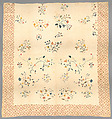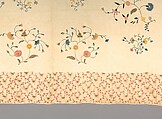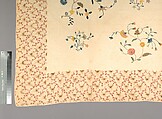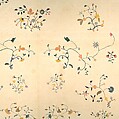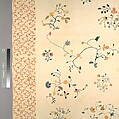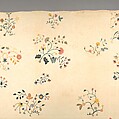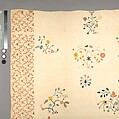Embroidered quilt
Mildred American
Not on view
In the years before the American Revolution, when this quilt was made, both Connecticut and New York were well-established as separate colonies. However, to the people living in the neighboring towns of Greenwich, Connecticut and Rye, New York, on the coast of the Long Island Sound, the border between the two colonies was more or less permeable. At different moments during the preceding century, this area was either part of the territory of New Amsterdam, (later New York) or New England. No matter what the area’s momentary allegiance, what was probably more important at the time to the young woman named Mildred who embroidered her name, the date, and the location of "Cos Cob—Rhy" on the quilt, was that Rye, New York and Greenwich, Connecticut (which encompasses the area around Cos Cob Harbor) were adjoining towns. In fact, Rye was founded in 1660 by settlers from Greenwich, and members of the same extended families lived in both towns. Cos Cob Harbor, the area to which Mildred referred, was Greenwich’s primary shipping port, where local farm produce was loaded aboard boats bound for New York City some thirty miles away. The area around the busy harbor was settled beginning in the early eighteenth-century—it is probable that Mildred’s family had a house there.
The central area of the quilt, made up of three large embroidered panels and several small partial pieces of embroidery, was completed in 1753. Different size floral sprigs are embroidered using crewel wools in chain stitch on a fine linen ground fabric. The three large panels (two at the bottom, one in the center of the upper area) are all about the same size, between 36 and 38 inches high and about 31 inches wide (91.4/96.5 x 78.7 cm). Two bottom panels are embroidered as mirror images of each other; the upper panel shows a different floral composition. Two mirror-image panels flank the large upper panel, and it is within these two narrow panels (each about 13 in., or 33 cm wide) that the inscription appears, cross-stitched in beige silk. Clearly reversed from its original format, the inscription reads "COS COB-RHY/ 53" on the left narrow panel and "MILDRED/ 17" on the right narrow panel. It would make far more sense if Mildred had inscribed her work so that it read: "MILDRED/ COS COB-RHY/ 17/ 53," and it is likely that this was once the case. The embroidered panels that make up the quilt once had another use; although they could have been curtain or bed-hanging panels (see 22.55 and 61.48.2), because of their size, it seems more likely that they once were stitched together into the skirt made by Mildred in 1753.
By the later decades of the eighteenth century, Mildred’s embroidered skirt may have seemed old-fashioned, or maybe it simply no longer fit her. It is also possible that it had been passed down to another female member of the family. But judging by the style of the printed fabric in the border, some years later, probably around 1780, someone took the skirt apart and re-attached the pieces in the current lay-out, not noticing the correct order of the light-colored inscription. This person then added newly purchased border fabric, a cotton printed with a small floral vine arranged in a diaper pattern. Without adding a layer of batting, she quilted the new quilt top to a backing of heavier-weight plain-weave linen with blue linen thread in an overall chevron pattern.
Due to rights restrictions, this image cannot be enlarged, viewed at full screen, or downloaded.
This artwork is meant to be viewed from right to left. Scroll left to view more.
